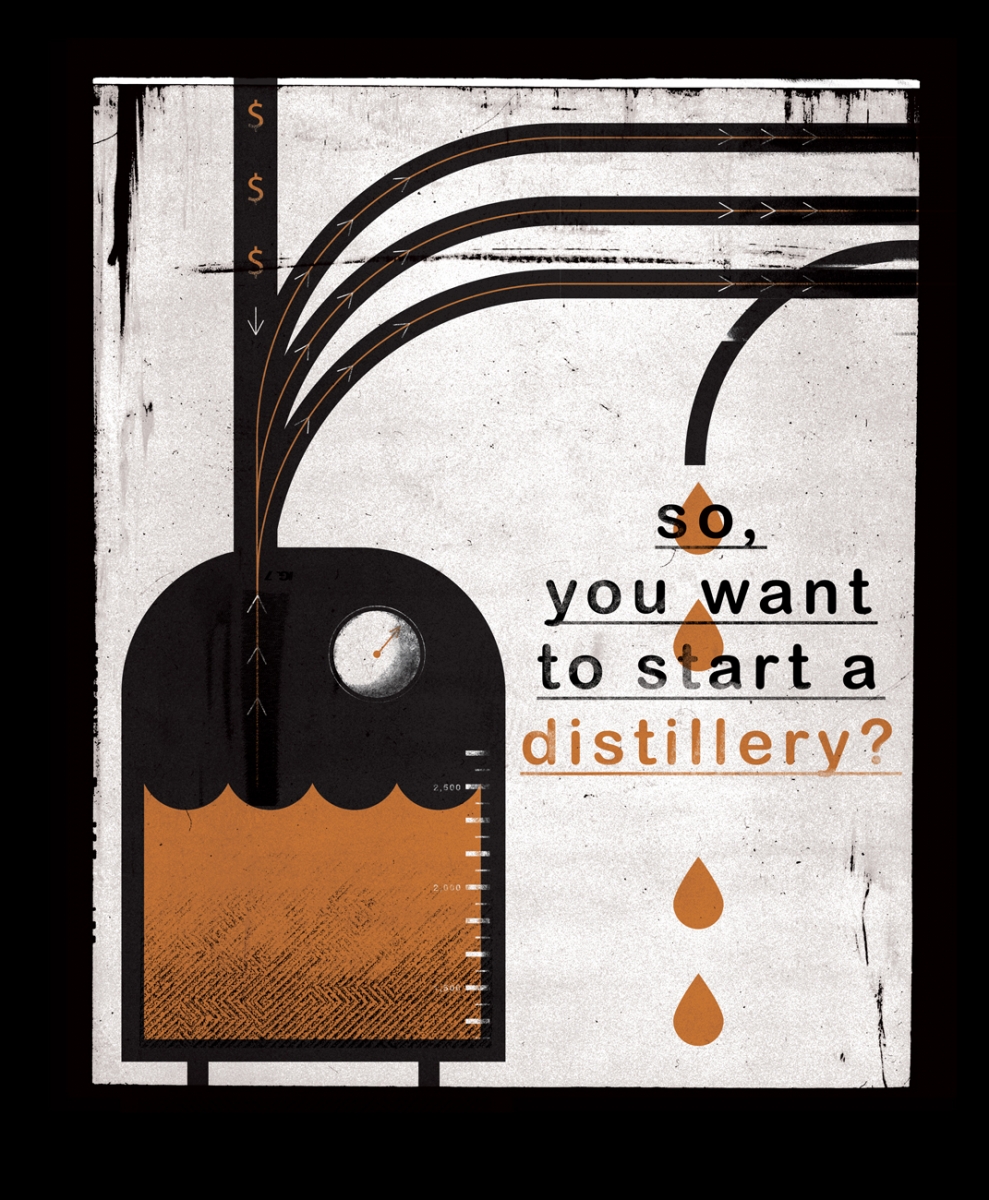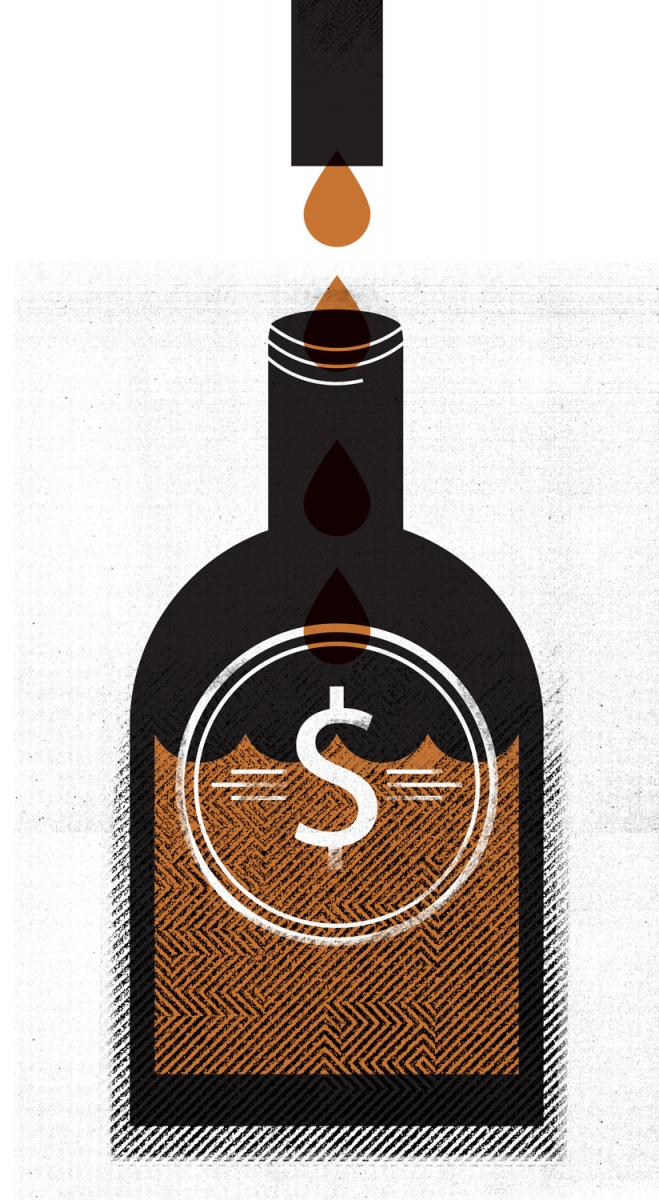
When Geoff Stewart talks about Rig Hand Distillery (formally Big Rig Distillery) – a venture born of equal parts risk, opportunity and hooch – it’s surprising to learn that he’s only been in the business for two years.
The co-founder of Rig Hand Distillery walks around the 6,200 square-foot, Nisku-based factory of fine intoxicants like it was a calling. His tattooed arms gesture deftly at chrome and brass pipes and pots with knowledge befitting a veteran of countless expository tours for booze-lovers and prospective distillers alike.
Still, it wasn’t long ago that local liquor store shelves were mostly empty of anything 40 per cent alcohol by volume and made in the province, and only three companies were making hard liquor on Albertan soil: Black Velvet Distilling Company, Highwood Distillers Ltd. and Alberta Distillers Ltd.
Now, according to the Alberta Gaming and Liquor Commission, there are approximately 400 different hard liquors produced in the province, 122 of which are produced by new, small distilleries.
Late in 2013, the Government of Alberta eliminated the minimum required output for distilleries and breweries – formerly, among other things, a distillery needed to be able to produce 2,500 hectolitres a year to get the necessary provincial licensing.
Craft beer has since taken off in the province, with the Alberta Small Brewers Association representing dozens of homegrown craft beer-makers, but distillers have been slower on the uptake.
It’s increasing steadily, though, and the AGLC noted 12 new applications at varying stages of completion by the end of 2016.
Nearly 30 kilometres away from Rig Hand, another distillery is in its early stages.
Nestled just off Whyte Avenue in the old blue boom-town building that used to be The Baby Seal Club, one of Stewart’s early proteges is hard at work, making Edmonton’s first home-grown liquor – moonshining notwithstanding.
Adam Smith, who also owned the now-defunct venue in which his operation is housed, named the new venture Strathcona Spirits.

Smith, Stewart recalls, used to hang around Rig Hand. Stewart offered to let the novice distiller work for experience and, eventually earn an old still which he had lying around. And Smith isn’t the only new start in town. Hansen Distillery, located in Edmonton’s west side, has also recently opened its doors.
But, even with new doors opening all the time, the process of putting a fledgling distillery into operation is long and not without its pitfalls.
Smith recalls his early days in the business. Finding the equipment meant a long drive down to the Ozarks, where moonshining is still common, buying a still, then lugging it back to Canada in the back of his truck. Finding stills in Canada isn’t easy, he says, adding that many up-and-coming distilleries turn to the United States for this essential piece of equipment. Stewart, through Rig Hand, has begun distributing stills for a Missouri-based company called Affordable Distillery Equipment, which is a bit of a misnomer, given that quality stills can set a buyer back tens of thousands of dollars.
Other bits of equipment can come a little closer to home, like Stewart’s aged grain cracker, which he took from his family’s farm. Surrounded on all sides by agriculture, distilling in Alberta creates easy access to quality local grains and botanicals. According to Stewart, 75 per cent of the grain Rig Hand uses comes from within a mile of his operation and all of the herbs, spices and other flavours Smith uses come from within the province.
Stewart recalls meeting his grain supplier by chance, while he was broken down by the side of the road on his tractor.
“I asked if he needed a ride,” Stewart says. “That’s pretty Alberta right there.”
Despite access to the province’s golden fields of grain, small-time distillers suffer for a price point. While big players in the market can buy bulk ingredients at a more affordable price, those just starting out can’t buy as much, nor produce as much of the final product.
It’s a point of pride for craft distilleries to have everything done by hand, with the exception of the bottle-filler, which needs to be accurate to the millilitre or else they could face fines, Stewart says.
Stewart estimates that a premium vodka sold at $26 for a two-six would make the producer $0.44 per bottle, which is fine when a company sell hundreds of thousands of them around the world, and when the company can purchase ingredients in bulk.
But when Rig Hand, for example, sells roughly 1,500 a month and uses locally-sourced ingredients not purchased at the same bulk price-point and without automation, the profit margin needs to be greater. So 750 ml of vodka is going to end up in the $50-$60 range.
Like most small businesses, distilleries face a staggering, prohibitive number of challenges, but there’s hope. While Ryan Engen, director of spirits for Alberta Liquor Stores North America, which represents brands like Liquor Depot and Wine and Beyond, can’t give any hard numbers on how much locally made hooch sells in the province, he does know that people are becoming increasingly willing to swallow the cost to taste something made close to home.
“I think overall customers gravitate a lot towards local, more and more now than say four or five years ago,” he says.
As the number of distilleries in Alberta increases, so too does the competition between the businesses in the region. Stewart isn’t worried.
There’s competition, sure, but he doesn’t see the current, and incoming, members of the Alberta Craft Distillers Association as conquests, but rather as teammates.
If, for example, Park Distillery, located in Banff, decides to make a spicy chili vodka, Stewart says that Rig Hand will try to avoid stepping on that particular toe.
“We don’t need to fight amongst ourselves over the crumbs the big guys let fall on the ground. We can work together to steal a bigger market share as a group,” he says.
It took Rig Hand 10 months to get the necessary licensing, Stewart says, though he also admits that it’s getting easier.
And, Stewart admits, his operation started off big. For Stewart and his wife, this meant selling off a few rental properties, cashing in their RSPs and taking out a mortgage on their home. When they went around to banks with their 95-page business plan, hoping for a loan, no one would touch them. The industry was still too new and untested.
So they did it with a cool $1 million of their own money. As he recalls this, the reality of the risk seemed to temper his enthusiasm for the venture, though it passes quickly.
“We’re rolling the dice with our life savings. It’s not easy.”
Prior to opening Rig Hand, Stewart toured 19 different distilleries with a list of questions in tow. When he asked each of the operations what their biggest mistakes were, the answer came back that they started too small. The logic went like this: A distillery started off small and then, six months later, it had to get bigger, so it sold its old equipment for cheap – Stewart estimates the sale being 50 cents on the dollar. Around six months later, it had to do it again, and then again.
“So every six months they’re losing half their investment. That didn’t make sense to me, so I thought, ‘Why not bite the bullet?'” he says.
When all the dust from the buying and paperwork settles, it’s finally time to make booze, most often vodka or a derivative, like gin, which is just vodka with juniper and other flavours. Whiskies, despite being a big cash cow for distillers, legally need to age in barrels for a minimum of three years in Canada; otherwise they have to go by the decidedly un-sexy name of white distillate.
Like equipment, know-how in the business is often outsourced outside of the province. Smith, for example, was apprenticed in part by a master distiller in Oregon, while Stewart, formerly a moonshiner, had to study Distilling at the Artisan Craft Distilling Institute in Seattle. They both toured operations across North America extensively prior to taking the dive.
And once the basics are down, the mad science can begin. Smith gently wafts vapours from a few mason jars filled with discoloured liquids, tinctures of high-proof alcohol and herbs away from which he keeps his nose hairs a safe distance. There’s something about craft distillers: They don’t seem happy with just the pre-ordained recipes for their hooch.
Smith rattles off a few of his prototypes – sarsaparilla, angelica and a Scoville-heavy chili-pepper concoction – then says that a keen palate is essential in the business.
Perhaps, though, for a small business in an unexplored market, the biggest boost can come closest to home.
“You have to rely on a lot of help from friends, and you have to have a supportive partner,” Smith says.
“I’m lucky I have a lot of very supportive people around me who helped make this happen.”
The Paperwork
No pursuit, regardless of how noble, would be complete without paperwork. A distillery needs to pay a bond (which depends on the size of the operation) to the federal government’s excise department to ensure that its owners don’t just up and leave. It pays a duty on each bottle it sells.
Provincially, aspiring distillers need a Class E license from the AGLC, a process with four steps.
The first is a preliminary assessment, where the operation provides information about what it will produce, including floor plans, designs and proposed distribution areas.
Next, the application will be placed on the AGLC’s website for 21 days to allow nearby residents a chance to protest the construction.
According to the AGLC, there’s an application fee of $200 to get the ball rolling, then, once approved, the distillery must pay $2,000 its first year. There is a sliding scale for how much a distillery pays each subsequent year.
According to Bill Robinson, president and CEO of the Alberta Gaming and Liquor Commision, the AGLC is trying to ease this process and has created a “one touch-point” system, a single representative from the organization to help usher applicants through the process, to facilitate this.
Like this content? Get more delivered right to your inbox with Ed. Eats
A list of what’s delicious, delectable and delightful.








